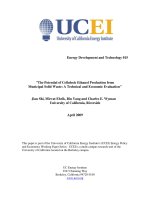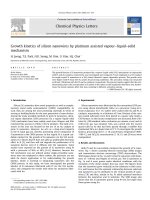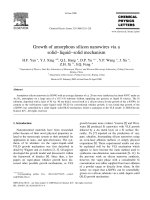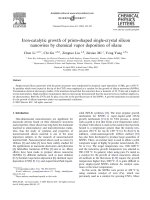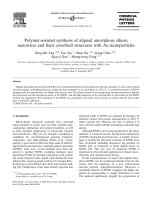- Trang chủ >>
- Khoa Học Tự Nhiên >>
- Vật lý
Growth of amorphous silicon nanowires via a solid–liquid–solid mechanism
Bạn đang xem bản rút gọn của tài liệu. Xem và tải ngay bản đầy đủ của tài liệu tại đây (323.06 KB, 5 trang )
16 June 2000
Ž.
Chemical Physics Letters 323 2000 224–228
www.elsevier.nlrlocatercplett
Growth of amorphous silicon nanowires via a
solid–liquid–solid mechanism
H.F. Yan
a
, Y.J. Xing
a,b
, Q.L. Hang
a
, D.P. Yu
a,)
, Y.P. Wang
a
,J.Xu
a
,
Z.H. Xi
b
, S.Q. Feng
a
a
Department of Physics, State Key Laboratory of Mesoscopic Physics, and Electron Microscopy Laboratory, Peking UniÕersity,
Beijing, China
b
Department of Electronics, Peking UniÕersity, Beijing, China
Received 23 February 2000; in final form 26 April 2000
Abstract
Ž.
Amorphous silicon nanowires a-SiNW with an average diameter of ca. 20 nm were synthesized at about 9508C under an
Ž.
ArrH atmosphere on a large area of a 111 Si substrate without supplying any gaseous or liquid Si sources. The Si
2
Ž.
substrate, deposited with a layer of Ni ca. 40 nm thick , served itself as a silicon source for the growth of the a-SiNWs. In
Ž.
contrast to the well-known vapor–liquid–solid VLS for conventional whisker growth, it was found that growth of the
Ž.
a-SiNWs was controlled by a solid–liquid–solid SLS mechanism, which is analogous to the VLS model. q 2000 Elsevier
Science B.V. All rights reserved.
1. Introduction
Nanostructured materials have been researched
either because of their novel physical properties re-
lated to the mesoscopic system or their potential for
application in nano- and opto-electronics. The syn-
thesis of Si whiskers via the vapor–liquid–solid
Ž.
VLS growth mechanism was first described in
wx
detail by Wagner and co-workers 1–3 . Givargizov
developed the growth model and discussed it within
wx
the framework of kinetics 4 . Since then, a few
papers on vapor-phase whisker growth have dis-
cussed other possible growth mechanisms, as VLS
)
Corresponding author. Fax: q86-10-62751615; e-mail:
wx
growth became more evident. Yazawa 5 and West-
wx
water 6 produced Si nanowires with VLS growth
induced by a Au metal layer on a Si surface. Re-
wx
cently, Yu 7 reported on the production of very
pure, ultrafine, freestanding silicon nanowires using
an oven-laser ablation method, or simply physical
wx
evaporation 8 . These experimental results can also
be explained well by the VLS mechanism which
appears to have become the main method used to
wx
synthesize one-dimension nano-materials 9–11 . In
the previous work on silicon nanowire synthesis,
however, the vapor phase with a considerable Si
concentration was either supplied from laser ablation
of a powder target or directly from silane. In this
Letter, we report that a-SiNWs can be controllably
grown on a silicon substrate via a solid–liquid–solid
Ž.
SLS growth mechanism.
0009-2614r00r$ - see front matter q 2000 Elsevier Science B.V. All rights reserved.
Ž.
PII: S0009-2614 00 00519-4
()
H.F. Yan et al.rChemical Physics Letters 323 2000 224–228 225
2. Experimental
Ž
y2
.
Heavily doped 1.5= 10
V
rcm n-type Si
Ž.
111 chips were used as substrate. The silicon sub-
strate was cleaned ultrasonically in pure petroleum
ether and in ethanol in turns for 5 min, leached in
distilled water, and then dried. A thin 40 nm layer of
nickel was thermally deposited on the substrate which
was then placed in a quartz tube which heated in a
Ž. Ž
tube furnace at 9508C. Ar 36 sccm and H 4
2
.
sccm were introduced during growth at an ambient
pressure of about 200 Torr. After cooling down to
room temperature, a thin layer of gray-colored de-
posit was found on the surface of the substrate. An
Amray FEG-1910 scanning electron microscope
Ž.
SEM , and a Hitachi-9000NAR high-resolution
Ž.
transmission electron microscope HREM equipped
Ž.
with energy dispersive spectrum EDS were em-
ployed for analysis of the morphology and mi-
crostructure of the product.
3. Results and discussion
Fig. 1a shows in plan view a SEM image reveal-
ing the general morphology of the Si nanowires
Ž.
grown on a large area 10= 10 mm of 111 Si
substrate after a 1 h period of growth. EDS analysis
Ž.
inset proved that the nanowires consist mainly of
silicon. A trace amount of oxygen exists in the
a-SiNWs, which was attributed to surface oxidation
when the freshly made nanowires were exposed to
air, because the growth process was controlled under
a reduction atmosphere with a mixture of argon and
hydrogen. The nanowires grew directly on the sub-
strate without introduction of another Si source in
the vapor phase. It can be seen that the deposit
consists of nearly pure SiNWs. The growth rate of
the nanowires is estimated to be ca. 30 nmrs. The
TEM image shown in Fig. 1b reveals that the SiNWs
have a smooth morphology, a diameter of 10; 50
nm, and a length of up to a few tens of micrometers.
Ž.
The highly diffusive ring pattern inset of selected
Ž.
area electron diffraction SAED revealed that the Si
Ž.
nanowires are completely amorphous a-SiNW . The
growth environment is quite different from that of
laser ablation, or physical evaporation, and indeed
reveals a different growth mechanism.
Ž.
Fig. 1. a SEM micrograph showing the general morphology of
the SiNWs grown using an SLS growth mechanism. Inset: an EDS
Ž.
spectrum with the peak corresponding to Si. b TEM image
revealing that the SiNWs have a smooth morphology and average
diameter of ca. 40 nm. The SAED pattern shown in the inset
reveals a characteristic diffusive ring pattern, showing that the
nanowires are completely amorphous.
wx
In the case of oven-laser ablation 7 , the silicon
source for SiNW growth was supplied from the
vapor phase in which the atomic Si species was
ablated off by the laser beam. While in the high-tem-
wx
perature evaporation method 8 , sufficient silicon
atoms were evaporated at high temperature from the
powder target due to the extremely high specific
ratio of surfacervolume compared to bulk silicon.
Such a high specific surfacervolume ratio guaran-
tees a Si concentration high enough in the vapor
phase. In these two cases, growth of the SiNWs is
controlled by the well-known vapor–liquid–solid
Ž.
VLS mechanism, in which the vapor phase plays
an important role in the growth of the SiNWs. The
central idea behind VLS growth of SiNWs is that the
Ž.
catalysts usually Ni, or Fe as impurity act as a
liquid-forming agent which reacts with the vapor
()
H.F. Yan et al.rChemical Physics Letters 323 2000 224–228226
phase and forms NiSi eutectic liquid droplets. The
2
vapor phase is rich in Si atoms. Upon further absorp-
tion of Si atoms into the droplets from the vapor
phase, the droplets become supersaturated, resulting
in the precipitation of SiNWs from the droplets.
Under the present conditions, however, the Si
concentration in the vapor phase is negligible at
the growth temperature because the specific
surfacervolume ratio of bulk Si substrate is ex-
tremely low compared with that of the micro-sized
Si powder target, or in the case of laser ablation. On
the other hand, the Si substrate was covered by a thin
layer of Ni. Therefore, the only possible silicon
source comes from the bulk silicon substrate because
no extra Si source was introduced into the vapor
phase. From the binary Ni–Si diagram, it can be
seen that the eutectic point of Si Ni is 9938C. How-
2
ever, due to the melting effect of small-size grains,
the eutectic compound NiSi can begin to form at a
2
temperature lower than 9938C. As we have proven,
the deposited Ni film can react with the Si substrate
at a temperature above 9308C, and forms Si Ni
2
eutectic liquid alloy droplets. Because of the rela-
tively high solubility of Si in Si Ni eutectic alloy,
2
Ž
more Si atoms will diffuse through the solid sub-
.Ž
strate –liquid interface into the liquid phase i.e., the
.Ž.
Ni Si droplets . A second liquid–solid nanowire
2
interface will form when the liquid phase becomes
supersaturated due to thermal or compositional fluc-
tuations, resulting in the growth of SiNWs. Because
this growth process involves solid–liquid–solid
phases, it is called SLS growth which is, in fact, an
analogous to the VLS mechanism. The growth pro-
cess of a-SiNWs via an SLS model is depicted
schematically in Fig. 2.
Cross-sectional SEM analysis of the sample pro-
vided direct evidence to support a-SiNW growth via
an SLS mechanism. Fig. 3a shows a low-magnifica-
tion cross-sectional SEM image. It is visible that a
layer of a-SiNWs with a thickness of ca. 20 mm
were grown on the substrate. EDS analysis between
the Si substrate and a-SiNW layer further confirmed
the existence of a thin layer of Si–Ni alloy, as
indicated by a white arrow. In the magnified cross-
sectional SEM image in Fig. 3b, it is more clearly
revealed that a-SiNWs were grown directly on the
Si–Ni layer. TEM investigation showed that the
Si–Ni alloy layer consists of nanoparticles of a few
Fig. 2. Schematic depiction of SiNW growth by the SLS mecha-
Ž. Ž .
nism: a deposition of a thin layer of Ni on the Si 111 substrate;
Ž. Ž.
b formation of the Si–Ni eutectic liquid droplets; c continuous
Ž.
diffusion of Si atoms through the substrate–liquid SL interface
into the liquid droplets, and growth of SiNWs through the liquid–
Ž. Ž.
wire LS interface; d final state of SiNW growth. The smooth
surface of the original substrate becomes rough at the end of
SiNW growth.
tens of nanometers. We also found that the a-SiNWs
grow from a base, which manifests itself by the fact
that the solidified Si–Ni nano particles were visible
between the surface of the substrate and the a-SiNW
film, instead of being attached at the free tip of the
SiNWs.
One question about SLS growth is what is the
driving force for such a continuous diffusion of Si
atoms from the substrate through the substrate–liquid
interface into the liquid droplets, and then through
the liquid droplets–nanowire to stack themselves
into nanowires? From a kinetic point of view, the
concentration gradient and supersaturation due to the
fluctuation in Si–Ni liquid droplets are the driving
force of the growth. On the other hand, the carrier
gas ArrH will collide with the surface of the
2
semisphere-shaped Si–Ni liquid droplets and ex-
()
H.F. Yan et al.rChemical Physics Letters 323 2000 224–228 227
Ž. Ž.
Fig. 3. a Low and b magnified cross-sectional SEM images of
Ž.
the SiNWs grown on a Si 111 substrate controlled by an SLS
mechanism. The length of the SiNWs is ca. 20 mm. The Si–Ni
particles are visibly attached to the Si substrate surface.
change energy and momentum with the atoms at the
surface of the Si–Ni nanoparticles, causing overcool-
ing at the surface of the droplets. Such an overcool-
ing is critical to initiate the preferential unidirec-
tional growth of a-SiNWs. Although it is not yet
clear why the resultant nanowires are amorphous
instead of crystalline, we think that the amorphous
state is closely related to the more rapid speed of
growth under the present conditions.
Detailed photoluminescence measurements at
room temperature revealed that the a-SiNW film
emitted blue–green light, peaked at 445 and 480 nm,
respectively. According to our recent work on the
physical origin of the full visible-band light emission
wx
from crystalline Si nanowires 12 , however, such a
photoluminescence from the a-SiNWs was ascribed
as arising from defect centers in the amorphous SiO
x
layer sheathing the nanowires as well.
The silicon nanowires are interesting to evaluate
the quantum confinement effect related to low di-
wx
mensionality 12 . a-SiNWs grown on substrate have
a remarkable surfacervolume ratio, possibly show-
ing physical-chemical properties completely different
from the bulk. From this point of view, it is specu-
lated that a-SiNWs may have potential applications
such as for portable rechargeable batteries of high
capacity which is closely related to the surface ef-
fects. In fact, it was recently revealed that the lithium
battery using silicon nanowires as material for elec-
trodes showed a capacity as high as 8 times that of
wx
the ordinary material 13,14 . By optimizing dopants,
it is believed that the a-SiNW film thus prepared will
find application in future nanotechnology.
4. Conclusion
In conclusion, a-SiNWs were controllably grown
directly on a Si substrate without supplying a gaseous
or liquid Si source. It was shown that the growth of
a-SiNWs was different from those obtained using the
conventional VLS model. Instead, a-SiNWs were
grown using an SLS mechanism in which the sub-
strate served as a source of Si. The present results
also provide an alternative but simple approach for
nanostructure preparation.
Acknowledgements
This project was financially supported by the
national Natural Science Foundation of China
Ž.
NSFC and by the Research Fund for the Doctoral
Ž.
Program of Higher Education RFDP , China.
References
wx Ž.
1 R.S. Wager, W.C. Ellis, Appl. Phys. Lett. 4 1964 89.
wx Ž.
2 R.S. Wager, W.C. Ellis, Trans. Met. Soc. AIME 233 1965
1053.
wx Ž.
3 R.S. Wager, C.J. Doherty, J. Electrochem. Soc. 115 1968
93.
wx Ž.
4 E.I. Givargizov, J. Cryst. Growth 31 1975 20.
wx
5 M. Yazawa, M. Koguchi, A. Muto, M. Ozawa, K. Hiruma,
Ž.
Appl. Phys. Lett. 61 1992 2051.
wx
6 J. Westwater, D.P. Gosain, S. Tomiya, S. Usui, H. Ruda, J.
Ž.
Vac. Sci. Technol. B 15 1997 554.
wx
7 D.P. Yu, C.S. Lee, I. Bello, X.S. Sun, Y.H. Tang, G.W.
Zhou, Z.G. Bai, Z. Zhang, S.Q. Feng, Solid State Commun.
Ž.
105 1998 403.
wx
8 D.P. Yu, Z.G. Bai, Y. Ding, Q.L. Hang, H.Z. Zhang, J.J.
Wang, Y.H. Zou, W. Qian, H.T. Zhou, G.C. Xiong, S.Q.
Ž.
Feng, Appl. Phys. Lett. 72 1998 3458.
()
H.F. Yan et al.rChemical Physics Letters 323 2000 224–228228
wx Ž.
9 N. Ozaki, Y. Ohno, S. Takeda, Appl. Phys. Lett. 73 1998
3700.
wx
10 Z.G. Bai, D.P. Yu, H.Z. Zhang, Y. Ding, Q.L. Hang, G.C.
Ž.
Xiong, S.Q. Feng, Chem. Phys. Lett. 303 1999 311.
wx
11 H.Z. Zhang, Y.C. Kong, Y.Z. Wang, X. Du, Z.G. Bai, J.J.
Wang, D.P. Yu, Y. Ding, Q.L. Hang, S.Q. Feng, Solid State
Ž.
Commun. 109 1999 677.
wx
12 D.P. Yu, Z.G. Bai, J.J. Wang, Y.H. Zou, W. Qian, J.S. Fu,
H.Z. Zhang, Y. Ding, G.C. Xiong, S.Q. Feng, Phys. Rev. B
Ž.
59 1999 2498.
wx
13 H. Li, G.W. Zhou, D.P. Yu, X.J. Huang, L.Q. Chen, Z.
Zhang, unpublished.
wx
14 G.W. Zhou, H. Li, H.P. Sun, D. P Yu, Y.Q. Wang, L.Q.
Ž.
Chen, Z. Zhang, Appl. Phys. Lett. 75 1999 2447.
